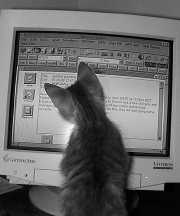|
ISH TIMES, Thursday, October 11, 2001 | ||
 | ||
|
WHAT IS IT about Ryanair? You book a £7 seat from their bargain basement on the World Web, you check in in very good time and before you know it you're 30,000 feet up in the air quaffing two glasses of excellent Bollinger special cuvée champagne for £20 each - and good value at that, for it has been delicately and lovingly aged for a minimum of three years with the utmost of scientific care in the depths of the Bollinger cellars before disgorgement - and then the young serving wench returns with your American Express card and a bill which shows you have now been deducted the princely sum of £380! "Ah," I hear you say. "So that's how Michael O'Leary makes his shilling!" But my companion was having none of it, and duly produced his grandfather's Mauser, a magazine rifle from 1906 but still in near pristine condition. At least it seemed so to this untrained eye, for it was a magnificent specimen, well oiled and - I can only presume - fully loaded and cocked. After we had exchanged a series of forgettable unpleasantries, or was it unforgettable pleasantries or whatever, the witch agreed to reimburse us the full amount, with a handwritten voucher for £380 that I can now redeem against the price of a total of no more than 12 Ryanair flights between now and October 10th 2006. On debarkation - or whatever the latest horrid little word is that our fine friends in the Americas have just minted for it - my friend was entertained in Dublin Airport by half a dozen tall and friendly chaps in handsome dark blue uniforms, and I haven't seen him since. Dublin Corporation
Talking of which, what is it about the first World War that makes it so different, so appealing? Is it the enormous casualties, the strife and suffering? The senseless and unnecessary loss of life on both sides? The unthinking idiocy of their generals? No, no and triple no. |

I have no need to remind you that the pomp and elegance of the Cossacks and Hussars - an elegant era of gold braid and vibrant, dashing colours - was by now long gone. And Hitler and his cronies and right-wing "style gurus" had not yet added the finishing touches to their evil brand of livery - literally putting the Sturm (und Drang) into the Sturmabteilung, that mesmerically sleek and streamlined look that would lead to so many pale imitators on the military equivalent of the catwalks of Europe and further afield in years to come. In terms of off-the-peg, ready-to-wear infantry garb, then, this period around 1914-20 was without doubt the British Empire's darkest hour - and Ireland's too of course. Fate sealed
The seeds of this unfashionable disaster were sown in the British Army's spring collection of 1914, on the eve of war's outbreak, by the then commander-in-chief of the British forces in Ireland, Sir Arthur Paget. Now if I were to call Paget a fat-witted, toady jackanape, a notorious villain of the highest order, and deeply detested in every modern fashion house and ragbag rattlebag ragbagandbobtail ragtrade from here to Azerbaydzhan even after all these years, this would still not do justice to that man's foolish tomknavery. |
There was to be further ignominy when the same military authorities decided to supplement the British garrison in Ireland with reinforcements from the prisons and poorhouses of these islands, as well as the gulags and gin palaces of English suburbia. What with the scarcity of the RIC's traditional (and - I will be the first to admit - quite attractive) bottle-green uniforms to go round, many of the new recruits in this motley crew were kitted out with khaki trousers or tunics, and the Irish Insurgents quickly dubbed this sartorially challenged fiasco "the Black and Tan Auxiliaries" - due to their striking similarity at the time to a popular beverage of the same name. Gerry Adams's beard
Meanwhile Michael Collins had fiendishly calculated that his men of terror should adopt a "Mountie" style uniform or, for the occasional rural skirmish, a more modern, loose and autumnal look, including trenchcoats from - what infamous irony! - Marks and Spencer's winter 1920 collection. Finally the ensemble was completed by a clever choice of accessories, including a wide range of rather fetching hats and the aforementioned Mauser. This so-called "Irregular" look, as it came to be known, evolved into the "army surplus" or balaclava and camouflage movement of the 1970s, and the rest, as they are so wont to say, is history. KEVIN MYARSE |
|
Other Irish satire: Ballyhoo | D'Ireland.com | E-jits | Evil Gerald | MaryCam | Meejalab | P45.net | ||